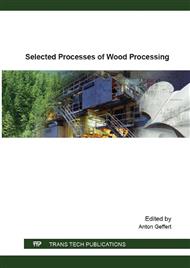[1]
K. Srinivas, K.K. Pandey, Photodegradation of thermally modified wood, J. Photochem. Photobiol. B. 117 (2012) 140-145.
Google Scholar
[2]
A. Burmester, Effect of heat-pressure-treatment of semi-dry wood on its dimensional stability, Holz Roh-Werkstoff. 31(6) (1973) 237-243.
Google Scholar
[3]
E. Giebeler, Dimensional stabilisation of wood by moisture-heat-pressure-treatment, Holz Roh-Werkstoff. 41 (1983) 87-94.
Google Scholar
[4]
O. Karlsson, E. Sidorova, T. Morén, Influence of heat transfering media on durability of thermally modified wood, Bioresources. 6(1) (2011) 356-372.
DOI: 10.15376/biores.6.1.356-372
Google Scholar
[5]
V. Repellin, R. Guyonnet, Evaluation of heat-treated wood swelling by differential scanning calorimetry in relation to chemical composition, Holzforschung. 59 (2005) 28-34.
DOI: 10.1515/hf.2005.005
Google Scholar
[6]
B. Esteves, J. Graca, H. Pereira, Extractive composition¸ and summative chemical analysis of thermally treated eucalypt wood, Holzforschung. 62 (2008) 344-351.
DOI: 10.1515/hf.2008.057
Google Scholar
[7]
V.M. Tuong, J. Li, Changes caused by heat treatment in chemical composition and some physical properties of acacia hybrid sapwood, Holzforschung. 65 (2011) 67-72.
DOI: 10.1515/hf.2010.118
Google Scholar
[8]
P. Bekhta, P. Niemz, Effect of high temperature on the change in color, dimensional stability and mechanical properties of spruce wood, Holzforschung. 57 (2003) 539-546.
DOI: 10.1515/hf.2003.080
Google Scholar
[9]
D. Kocaefe, S. Poncsak, G. Dore, R. Younsi, Effect of thermal treatment on the chemical composition and mechanical properties of Birch and Aspen, Bioresources. 3 (2008) 517-537.
Google Scholar
[10]
B.F.A. Bakar, S. Hiziroglu, P. Md Tahir, Properties of some thermally modified wood species, Materials and Design. 43 (2013) 348-355.
DOI: 10.1016/j.matdes.2012.06.054
Google Scholar
[11]
E. Windeisen, C. Strobel, G. Wegener, Chemische Charakterisierung von thermisch belastetem Holz: Bestimmung des Acetylgruppengehalts und FTIR Spektroskopie, Holz Roh Werkstoff. 61(6) (2003) 471-472.
DOI: 10.1007/s00107-003-0416-3
Google Scholar
[12]
E. Windeisen, G. Wegener, Chemical characterization and comparison of thermally treated beech and ash wood. Materials Science Forum. 599 (2009) 143-158.
DOI: 10.4028/www.scientific.net/msf.599.143
Google Scholar
[13]
P.H. Mitchell, Irreversible property changes of small loblolly pine specimens heated in air, nitrogen, or oxygen, Wood and Fiber Science. 20 (3) (1988) 320-355.
Google Scholar
[14]
M.J. Boonstra, J. van Acker, A. Pizzi, Anatomical and molecular reasons for property changes of wood after full-scale industrial heat-treatment, Proceedings Third European Conference on Wood Modification, 15-16th October Cardiff, UK (2007).
Google Scholar
[15]
E. Windeisen, C. Strobel, G. Wegener, Chemical changes during the production of thermotreated beech wood, Wood Sci. Technol. 41(6) (2007) 523-536.
DOI: 10.1007/s00226-007-0146-5
Google Scholar
[16]
R. Alen, R. Kotilainen, A. Zaman, Thermochemical behavior of Norway spruce (Picea abies) at 180–225°C, Wood. Sci. Technol. 36 (2002) 163-171.
DOI: 10.1007/s00226-001-0133-1
Google Scholar
[17]
H. Sivonen, S.L. Maunu, F. Sundholm, S. Jamsa, P. Viitaniemi, Magnetic Resonance Studies of Thermally Modified Wood, Holzforschung. 56 (2002), 648–654.
DOI: 10.1515/hf.2002.098
Google Scholar
[18]
B. Esteves, I. Domingos, H. Pereira, Pine wood modification by heat treatment in air, Bioresources. 3(1) (2008) 142-154.
DOI: 10.15376/biores.3.1.142-154
Google Scholar
[19]
M. Poletto, A.J. Zattera, R.M. Santana, Thermal decomposition of wood: kinetics and degradation mechanisms, Biores. Technol. 126 (2012) 7-12.
DOI: 10.1016/j.biortech.2012.08.133
Google Scholar
[20]
S. Yildiz, E.D. Gezer, U.C. Yildiz, Mechanical and chemical behaviour of spruce wood modified by heat, Building and Environment. 41 (2006) 1762-1766.
DOI: 10.1016/j.buildenv.2005.07.017
Google Scholar
[21]
A. Sluiter, R. Ruiz, C. Scarlata, J. Sluiter, D. Templeton, Determination of Extractives in Biomass: Laboratory Analytical Procedure (LAP). NREL/TP-510-42619. Golden, CO: National Renewable Energy Laboratory (2008).
DOI: 10.2172/937357
Google Scholar
[22]
A. Sluiter, B. Hames, R. Ruiz, C. Scarlata, J. Sluiter, D. Templeton, D. Crocker, Determination of Structural Carbohydrates and Lignin in Biomass: Laboratory Analytical Procedure (LAP). NREL/TP-510-42618. Golden, CO: National Renewable Energy Laboratory (2011).
DOI: 10.2172/1021264
Google Scholar
[23]
V.K. Seifert, Űber ein neues Verfahren zur Schnellbestimmung der Rein-Cellulose, Das Papier. (1956) 301-306.
Google Scholar
[24]
L.E. Wise, M. Murphy, A.A. d'Addieco, Chlorite holocellulose, its fractionation and bearing on summative wood analysis and on studies on the hemicelluloses, PaperTrade J., 122(3) (1946) 35-43.
Google Scholar
[25]
F. Kačík, D. Kačíková, T. Bubeníková, Spruce wood lignin alteration after infrared heating at different wood moistures, Cellulose Chem. Technol. 40(8) (2006) 643-648.
Google Scholar
[26]
D. Kačíková, F. Kačík, D. Bubeníková, B. Košíková, Influence of fire on spruce wood lignin changes, Wood Research. 53(4) (2008) 95-103.
Google Scholar
[27]
M. Nuopponen, T. Vuorinen, S. Jämsä, P. Viitaniemi, Thermal modifications in softwood studied by FT-IR and UV resonance Raman spectroscopies, J. Wood Chem. Technol. 24 (2004) 13-26.
DOI: 10.1081/wct-120035941
Google Scholar
[28]
M. Nuopponen, T. Vuorinen, S. Jämsä, P. Viitaniemi, The effects of heat treatment on the behaviour of extractives in softwoodstudied by FTIR spectroscopic methods, Wood Sci. Technol. 37 (2003) 109-115.
DOI: 10.1007/s00226-003-0178-4
Google Scholar
[29]
B.F. Tjeerdsma, M. Boonstra, A. Pizzi, P. Tekely, H. Militz, Characterisation of thermally modified wood: molecular reasons for wood performance improvement, Holz als Roh- und Werkstoff. 56 (1998) 149-153.
DOI: 10.1007/s001070050287
Google Scholar
[30]
V. Kučerová, F. Kačík, R. Solár, J. Sivák, Comparison of various methods of cellulose determination after thermal loading of spruce wood, Acta Facultatis Xylologiae. 51(1) (2009) 5-10.
Google Scholar
[31]
I. Čabalová, F. Kačík, D, Kačíková, M. Oravec, The influence of radiant heating on chemical changes of spruce wood, Acta Facultatis Xylologiae. 55(2) 59-6.
Google Scholar
[32]
F. Kačík, T. Bubeníková, D. Kačíková, Spruce wood lignin alteration after infrared heating at different wood moistures, Cell. Chem. Technol. 40(8) (2007) 643-648.
Google Scholar
[33]
T. Elder, Effect of process conditions on the yield of pyrolytic products from southern pine, Wood Fiber Sci. 16(2) (1984) 169-174.
Google Scholar
[34]
B. Esteves, H. Pereira, Wood modification by heat treatment: a review, Bioresources, 4 (2009) 370-404.
Google Scholar


